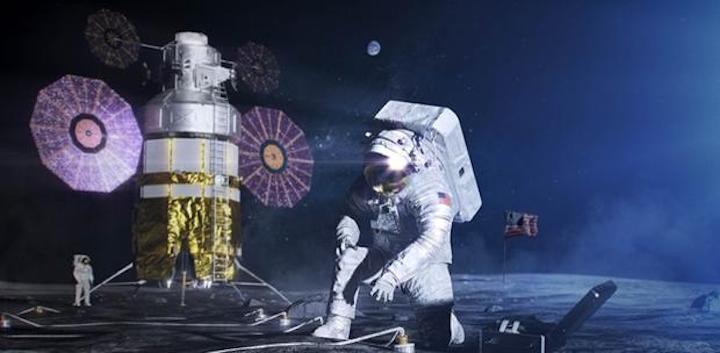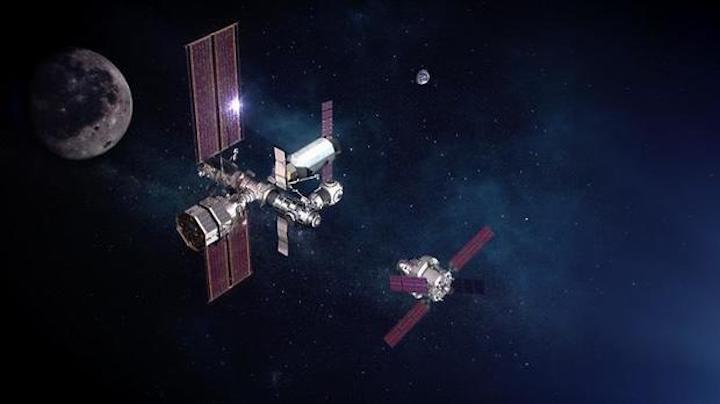23.09.2020

NASA remains committed to sending astronauts to the south pole of the moon by the end of 2024, but meeting that ambitious target will require Congress to fully fund development of a new moon lander in the agency's fiscal 2021 budget, Administrator Jim Bridenstine said Monday.
In a Lunar Exploration Program Overview document released earlier Monday, the agency said its Artemis moon program will cost $28 billion through fiscal 2025, including $7.6 billion for the huge Boeing-managed Space Launch System rockets, ground systems and Lockheed Martin Orion crew capsules that will carry astronauts to and from the moon.
Another $16.2 billion is required to develop, test and launch the new moon landers the program is depending on to carry astronauts to the lunar surface, the single largest chunk of the Artemis program's "phase 1" budget through 2025.
Phase 1 of the Artemis program covers three flights to the moon: an unpiloted test flight of the SLS booster and Orion capsule late next year; a piloted 10-day loop around the moon in 2023; and a piloted landing near the south pole of the moon in 2024. The budget also includes development of new spacesuits, the cost of resupply missions and development of exploration technologies.
The first Orion capsule is virtually complete and the first stage of the new SLS booster is being readied for a critical main engine test firing in October. If no major problems develop, the rocket and capsule should stay on track for their first launch late next year as planned.
But in a Monday afternoon teleconference, Bridenstine stressed that the 2024 moon landing target depends on Congress putting the requested $3.2 billion for lander development in NASA's fiscal 2021 budget. The Senate has not yet passed a budget bill and the House only included $628 million for lander development in its version.
Three teams are currently developing competing designs for the Human Landing System, or HLS: SpaceX, which holds an initial $135 million NASA contract; Dynetics, currently funded at $253 million; and a "national team," funded at $579 million, that includes Jeff Bezos' Blue Origin, Lockheed Martin, Northrop Grumman and Draper.
Bridenstine said he remains optimistic Congress will fully fund lander development because of what he described as broad bipartisan support for the Artemis program.
He said he's hopeful an expected continuing resolution that would freeze NASA's budget at last year's spending levels will be resolved in an "omnibus" spending bill before Christmas or, if the CR is extended, by early spring.
"It is critically important that we get that $3.2 billion," he said. "And I think that if we can have that done before Christmas, we're still on track for a 2024 moon landing. ... If we go beyond March, and we still don't have the human landing system funded, it becomes increasingly more difficult."
And what happens then?
"It's really simple. If Congress doesn't fund the moon landing program, then it won't be achieved (in 2024), I mean it's really that simple," Bridenstine said. But he quickly added: "I want to be clear, if they push the funding off, our goal will be to get to the moon at the earliest possible opportunity."

"Speed is still of the essence and sustainability follows speed," he told reporters. "So what I would tell you is if they keep delaying the funding, we will go to the moon at the earliest possible opportunity."
The Trump administration strongly supports a return to the moon and moved up an initial 2028 landing target to 2024. Phase 1 of the program as now envisioned calls for three flights to the moon by the end of 2024. Phase 2 is focused on establishing a sustainable presence on the lunar surface by the end of the decade.
Along with SLS rockets, Orion capsules and lunar landers, NASA's Artemis architecture also calls for building a small space station known as Gateway in a high orbit around the moon, one that can be altered as required to permit astronauts to land at virtually any point on the moon.
Maxar Technologies is designing Gateway's power and propulsion element while Northrop Grumman is designing a module known as the habitation and logistics outpost, or HALO. The European Space Agency is expected to provide a refueling and telecommunications element known as ESPRIT. Other modules may be added later.
The original Artemis architecture called for Orion crew capsules to dock at the Gateway, where the crew could transfer to an already docked lander for descent to the lunar surface. But use of Gateway is not required for the first moon landing, and the landers are being designed to dock directly with Orion capsules if desired.
Despite recent social media posts to the contrary, Bridenstine said NASA remains committed to sending the first Artemis crew to the moon's south pole where ice is believed to be present in permanently shadowed craters.
"We're going to the south pole," he said. "There's no discussion of anything other than that."
If ice is, in fact, accessible, astronauts eventually could use solar power to break it down into hydrogen and oxygen, providing rocket fuel, air and water for long-duration stays and eventual flights to Mars.
Quelle: CBS News
+++
NASA Publishes Artemis Plan to Land First Woman, Next Man on Moon in 2024

Following a series of critical contract awards and hardware milestones, NASA has shared an update on its Artemis program, including the latest Phase 1 plans to land the first woman and the next man on the surface of the Moon in 2024.
In the 18 months since NASA accepted a bold challenge to accelerate its exploration plans by more than four years and establish sustainable exploration by the end of the decade, the agency has continued to gain momentum toward sending humans to the Moon again for the first time since the last Apollo lunar mission in 1972.
“With bipartisan support from Congress, our 21st century push to the Moon is well within America’s reach,” said NASA Administrator Jim Bridenstine. “As we’ve solidified more of our exploration plans in recent months, we’ve continued to refine our budget and architecture. We’re going back to the Moon for scientific discovery, economic benefits, and inspiration for a new a generation of explorers. As we build up a sustainable presence, we’re also building momentum toward those first human steps on the Red Planet.”
In its formal plan, NASA captures Artemis progress to date, identifying the key science, technology and human missions, as well as the commercial and international partnerships that will ensure we continue to lead in exploration and achieve our ambitious goal to land astronauts on the Moon.
The agency’s powerful new rocket, the Space Launch System (SLS), and the Orion spacecraft are closer than ever to their first integrated launch. The spacecraft is complete while the core stage and its attached four engines are undergoing a final series of tests that will culminate in a critical hot fire test this fall.
Early Artemis Missions
Following a successful hot fire test, the core stage will be shipped to the agency’s Kennedy Space Center in Florida for integration with the spacecraft. NASA will launch an SLS and an Orion together on two flight tests around the Moon to check performance, life support, and communication capabilities. The first mission – known as Artemis I – is on track for 2021 without astronauts, and Artemis II will fly with crew in 2023.
In the Phase 1 plan, NASA notes additional details about conducting a new test during the Artemis II mission – a proximity operations demonstration. Shortly after Orion separates from the interim cryogenic propulsion stage, astronauts will manually pilot Orion as they approach and back away from the stage. This demonstration will assess Orion’s handling qualities and related hardware and software to provide performance data and operational experience that cannot be readily gained on the ground in preparation for rendezvous, proximity operations, and docking, as well as undocking operations in lunar orbit beginning on Artemis III.
While preparing for and carrying out these flight test missions, NASA already will be back on the Moon robotically – using commercial delivery services to send dozens of new science investigations and technology demonstrations to the Moon twice per year beginning in 2021.
In 2024, Artemis III will be humanity’s return to the surface of the Moon - landing the first astronauts on the lunar South Pole. After launching on SLS, astronauts will travel about 240,000 miles to lunar orbit aboard Orion, at which point they will directly board one of the new commercial human landing systems, or dock to the Gateway to inspect it and gather supplies before boarding the landing system for their expedition to the surface.
Wearing modern spacesuits that allow for greater flexibility and movement than those of their Apollo predecessors, astronauts will collect samples and conduct a range of science experiments over the course of nearly seven days. Using the lander, they will return to lunar orbit before ultimately heading home to Earth aboard Orion.
Work is progressing rapidly on the Gateway. NASA will integrate the first two components to launch – the power and propulsion element and the habitation and logistics outpost – in 2023. This foundation for the Gateway will be able to operate autonomously, conducting remote science experiments when astronauts are not aboard. NASA has selected the first two science instrument suites to conduct space weather investigations in lunar orbit before crew visits.
While NASA has not made a final decision to use the Gateway for Artemis III, Artemis IV and beyond will send crew aboard Orion to dock to the Gateway, where two crew members can stay aboard the spaceship in orbit while two go to the surface. Over time, the outpost will evolve, with new modules added by international partners, allowing crew members to conduct increasingly longer lunar missions.
As detailed in the agency’s concept for surface sustainability earlier this year, an incremental buildup of infrastructure on the surface will follow later this decade, allowing for longer surface expeditions with more crew. That concept calls for an Artemis Base Camp that would include new rovers, power systems, habitats, and more on the surface for long-term exploration of the Moon.
Throughout the Artemis program, robots and humans will search for, and potentially extract, resources such as water that can be converted into other usable resources, including oxygen and fuel. By fine-tuning precision landing technologies as well as developing new mobility capabilities, astronauts will travel farther distances and explore new regions of the Moon.
Quelle: NASA
